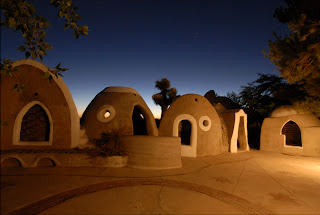EARTHSHIPS

An Earthship is a type of passive solar home made of natural and recycled materials. Designed and marketed by Earthship Biotecture of Taos, New Mexico, the homes are primarily constructed to work autonomously and are generally made of earth-filled tires, using thermal mass
construction to naturally regulate indoor temperature. They also usually have their own special natural ventilation system. Earthships are generally Off-the-grid homes, minimizing their reliance on public utilities and fossil fuels.
The original Earthships' designs were at first very experimental, but with practice and evolution the houses began looking attractive.
 Earthships are built to utilize the available local resources, especially energy from the Sun. For example, windows on sun-facing walls admit lighting and heating, and the buildings are often horseshoe-shaped to maximize natural light and solar-gain during winter months. The thick, dense inner walls provide thermal mass that naturally regulates the interior temperature during both cold and hot outside temperatures.
Earthships are built to utilize the available local resources, especially energy from the Sun. For example, windows on sun-facing walls admit lighting and heating, and the buildings are often horseshoe-shaped to maximize natural light and solar-gain during winter months. The thick, dense inner walls provide thermal mass that naturally regulates the interior temperature during both cold and hot outside temperatures.Internal, non-load-bearing walls are often made of a honeycomb of recycled cans joined by concrete and are referred to as tin can walls. These walls are usually thickly plastered with stucco.
The roof of an Earthship is heavily insulated – often with earth or adobe – for added energy efficiency.
Potential advantages
- Having an earth-bermed home with windows facing the sun is a good idea in any climate where heating is required.
- Collecting rainwater that falls on the roof reduces the runoff impact of the building and may reduce water and even sewer service fees.
- Having a combination of photovoltaic cells and wind generation is a prudent way to provide electricity in many situations.
- Using curved modules as horizontal arches to resist earth loads is a sound structural design.
- On-site processing of runoff water, grey water, and black water using plant beds reduces the environmental impact of the building.
- Rubber tires make a wind- and puncture- resistant wall. They may be safe from outgassing when plastered semi-airtight.
- Rubber tires are usually free and it may be possible to be paid to take them. It also is beneficial to keep them out of landfills or prevent them from being illegally burnt.
- Potential to eliminate utility bills.
- The structure is highly moldable to different aesthetic tastes.









